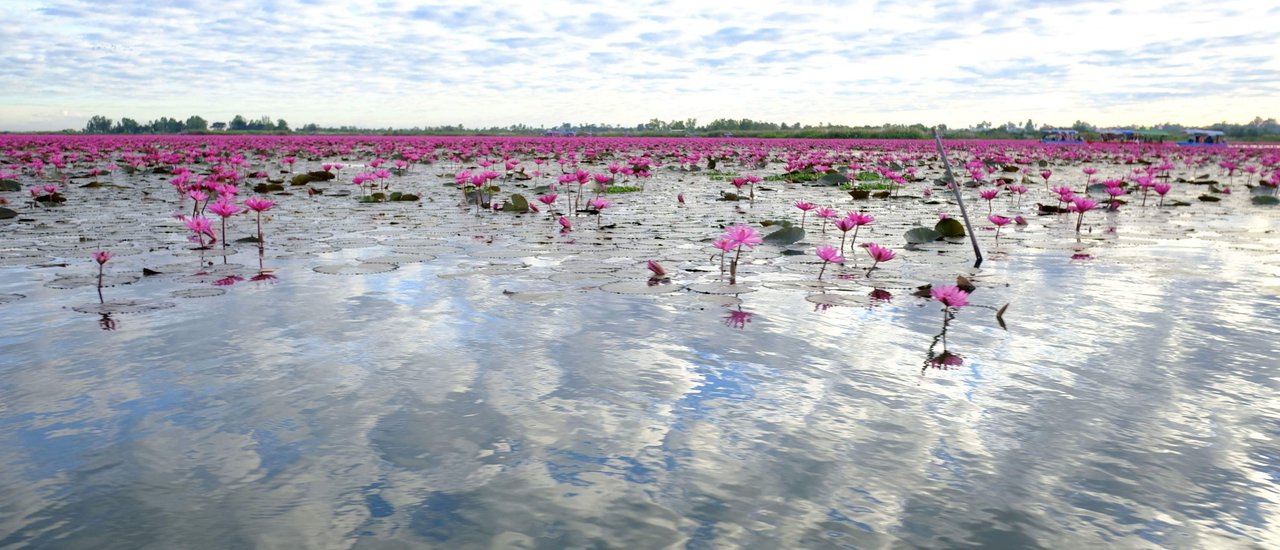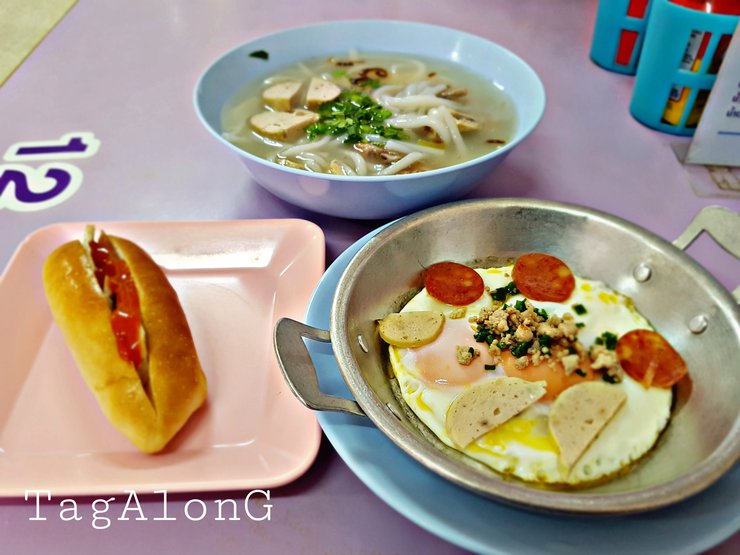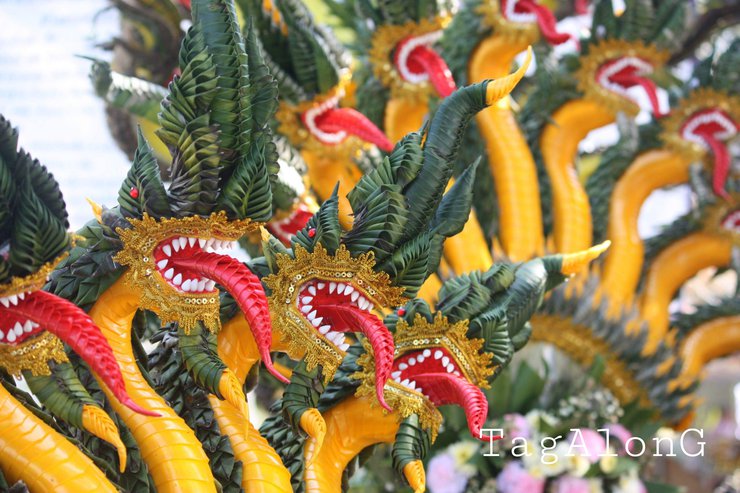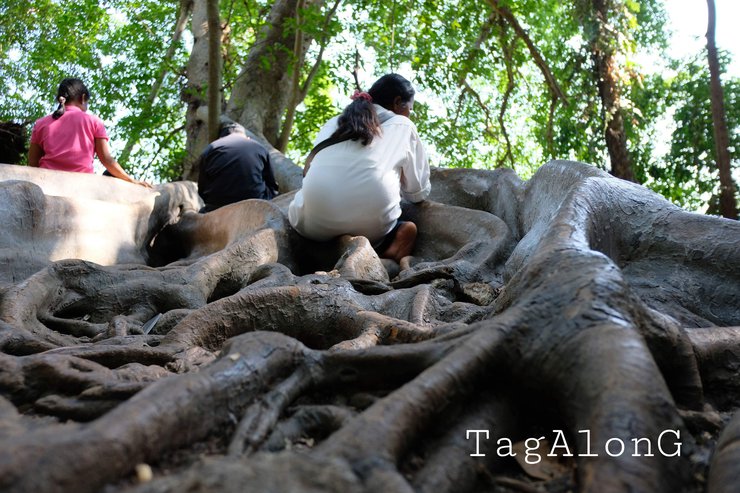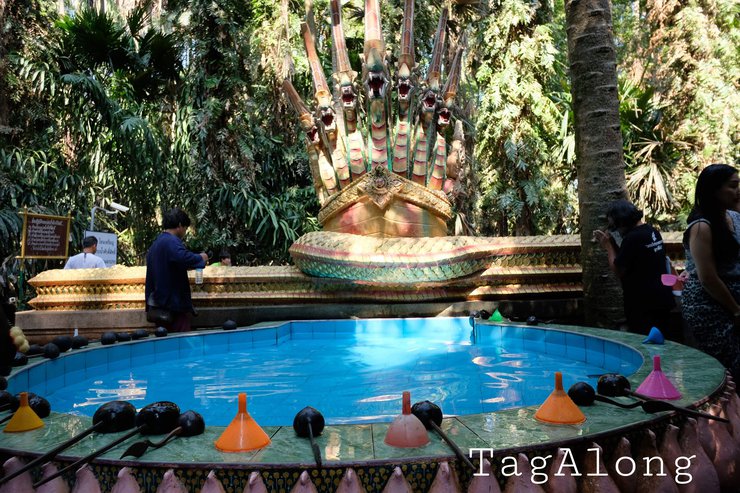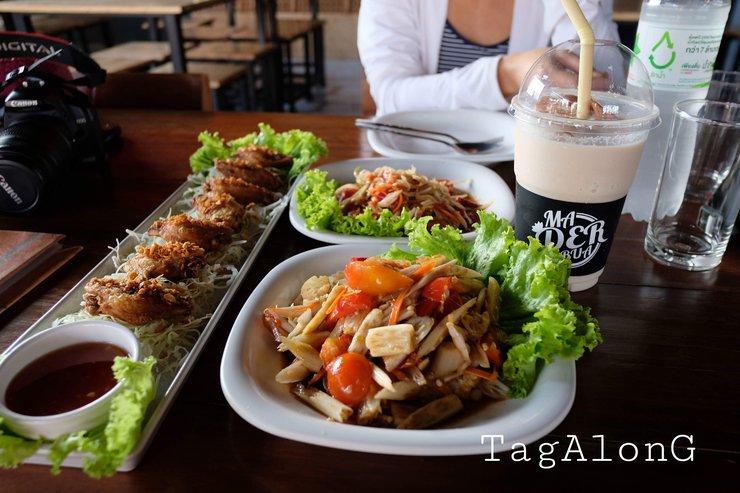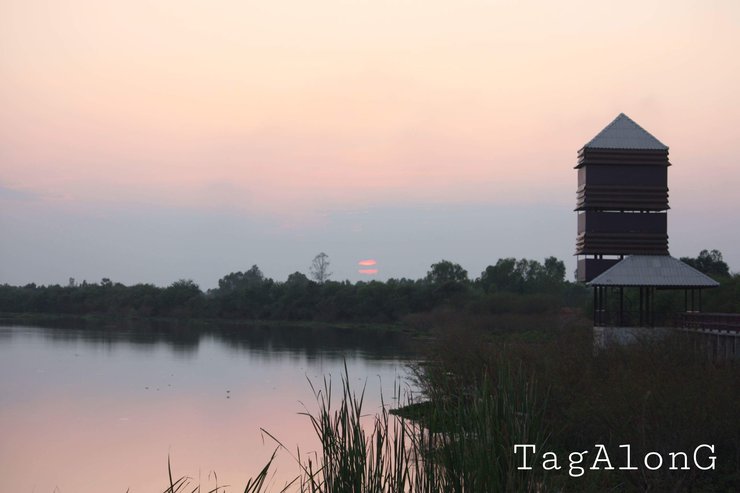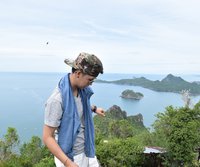We embarked on our journey from Bangkok at 11 p.m. on a Nakhonchai Air bus, heading towards Udon Thani. We arrived at the Udon Thani bus station a little after 7 a.m. Before we even stepped off the bus, a row of skylab tricycles were waiting for us. After negotiating a price we were happy with, 100 baht, the tricycle driver took us to Udon Thani Airport. We picked up our rental car and drove into the city in search of delicious khao piak. There were many menus to choose from. At the khao piak shop, we couldn't resist ordering the special khao piak with bone. At first, we thought we would get tender ribs, but the shop served a full drumstick. We also had fried eggs with bread and sticky rice cakes. These are Vietnamese dishes, similar to Vietnamese pancakes, but the wrapper is sticky, clear, and chewy.

The next destination is Pa Kham Chanod, following the trail of the serpent goddess Nang Nak. About 99 kilometers from the city, as we entered the area of Ban Kham Chanod, we began to see villagers setting up tables selling serpent offerings. Then, the music in the car started playing as if it were intentionally matching the atmosphere: "Where does love happen? It doesn't matter who it happens to. It will stay there forever, regardless of time." As the song ended, we arrived at the entrance of Wat Si Suthatho. Villagers waved us to park in the parking lot, where shops selling serpent offerings and betel nut leaves were set up all around. We bought a set for 180 baht and then walked into the temple, feeling a bit confused.

The air was thick with the heat and the clamor of the crowd as we approached the bridge leading to Koh Samui. Shops lined the path, selling everything from souvenirs to bottles of holy water. But as we stepped onto the bridge, the air cooled noticeably, and a sense of tranquility settled over us, despite the constant flow of people crossing in both directions. We carried our offering to the shrine of Pu Sri Suttho and Ya Sri Pathumma, where a Brahmin priest led the ceremony. Afterwards, we made our way to the giant fig tree, where a crowd was fervently scraping its base in search of lucky numbers. Their eyes gleamed with hope, some huddled together deciphering the patterns on the bark. Officials urged visitors to refrain from applying powder to the tree, yet traces of white dust were visible everywhere.

Not far away, there is a sacred well that is believed to be a passage to the navel of the Mekong River and the entrance to the underworld. In front of the well, there are people praying for blessings, some are scooping water to drink, wash their faces and sprinkle it on their bodies, while others are filling bottles with water to take home. On the way back, many people believe that if they rub the scales of the naga on their way out, they will have good luck. So we followed suit and rubbed the scales of the naga with a hundred baht bill all the way, wishing for wealth.

In the late afternoon, we left Kham Chanod and headed to our accommodation near Baan Diem Pier, where we would board a boat to see the Red Lotus Sea the next morning. The guesthouse we had booked was about a kilometer from the pier. Along the way, there were hardly any houses, shops, or restaurants, which made us a little worried about whether we would find anything to eat that evening. We met the owner of the guesthouse at Baan Diem School, which was nearby. There was only one grocery store in the area.
In the evening, we drove to explore the port and find dinner. There was only one restaurant open, and luckily, the food was delicious. The signature dish was lotus stem, and the restaurant's signature drink was a blended lotus stem milk shake, which was so delicious and creamy that we wanted more.

The late afternoon by the lake was rather quiet, devoid of tourists. The lotus flowers had closed, unlike their beautiful bloom in the morning. We waited to watch the sunset, but the sky was overcast that evening, offering no colorful spectacle. With nothing to see, we headed back to our accommodation early in the evening.

The next day, we woke up before dawn to see the red lotus sea. We left our accommodation at 6:15 am and arrived at the spacious parking lot within minutes. There were only a few cars parked, so we parked near the boat ticket booth. The morning atmosphere was bustling, unlike the previous evening. Along the walkway, there were shops selling fragrant grilled pork, sticky rice, roasted sweet potatoes, grilled Isaan sausages, steamed pork, and warm sticky rice. We hurried to the ticket booth. A small boat costs 300 baht and can accommodate 3 people for a round trip of one hour. A large boat costs 500 baht and can accommodate up to 5 people for a round trip of one and a half hours. The small boat is a long-tailed boat, which is more wobbly but has no roof, so there are beautiful photo angles with a panoramic view. As soon as we bought the tickets, we boarded the boat, the engine started, and the boat sped off on the water, spraying foam. The air was cool, refreshing, and invigorating.



The sun began to rise over the horizon as the boat sailed away. We quickly pressed the shutter button after the sun had risen above the water, and a pink line appeared in the distance. We became excited and our eyes were fixed on the sea of red lotuses. In a few moments, the red lotuses were everywhere. We tried to balance ourselves on the narrow long-tailed boat and find beautiful angles to take pictures. The boat moved to different spots for us to take pictures. After an hour, the boatman drove the boat back to the pier to wait for the next group of tourists.






In the late morning, we drove to Phu Phra Bat Historical Park. The roads were narrow, winding, and under construction in many sections, forcing us to slow down. We had time to admire the beauty of the villages and nature along the way. After driving about a hundred kilometers, we reached the uphill road. It was not steep, so we drove comfortably. The dry leaves were golden in color against the blue sky, and large rocks were visible at intervals until we reached the parking lot at the top.

Driving long distances often leads to the urgent need for a restroom. We were pleasantly surprised to find a spacious, clean, and beautifully decorated bathroom that was meticulously maintained. The mere sight of the bathroom indicated the high quality of the establishment's management.
After completing our personal errands, we proceeded to purchase tickets for the park. The entrance fee was only 30 baht per person, which prompted us to inquire with the ticket officer about the source of funding for park development given the low admission cost. The officer clarified that Phu Phra Bat Historical Park receives financial support from the Fine Arts Department.

While researching tourist attractions in Udon Thani, I must admit that Phu Phra Bat did not initially seem appealing. The photos I saw online were not particularly captivating, and I almost excluded it from my itinerary. However, after reading reviews and numerous comments, I discovered a consistent theme: the overwhelming beauty of the place and the strong recommendation to visit.
Upon witnessing it firsthand, its beauty surpassed the photographs, making the long drive worthwhile.


The following is a translation of the provided text:
The rock formations and cliffs of Phu Phra Bat are a result of natural erosion, which has created unique shapes due to the varying hardness of the rocks. Additionally, there is evidence of an ancient civilization dating back 2,000-3,000 years. This is demonstrated by the presence of rock paintings, carved Buddha statues, and evidence of religious ceremonies, such as water wells and drainage systems. These remnants are scattered throughout the area.







Initially, we planned to spend only 1-1.5 hours at Phra Phutthabat Temple under the scorching sun. However, it ended up taking us a full 3 hours to explore the entire temple complex.
After a long walk, we started to feel hungry. Within the park, there was only one restaurant serving cooked-to-order dishes. This restaurant had open-air seating that was comfortable and not stuffy like typical restaurants. The food was delicious and to our liking. Everything here seemed perfect, so we were very impressed with this place.
Leaving Phra Phutthabat around half past three, we rushed to Wat Pa Phu Kon, which was 50 kilometers away. Along the way, we passed many temples and meditation centers. Each one was large, but also looked very quiet and peaceful. The road up to Wat Pa Phu Kon was quite steep, and we were secretly worried that the Swift we had rented wouldn't make it.


Phu Khon Temple is a large, clean, and beautiful temple with panoramic views. The buildings are a modern adaptation of Thai architecture from the Rattanakosin period, without excessive ornamentation. Covering an area of over 3,000 rai, Phu Khon Temple offers a peaceful environment suitable for meditation and spiritual practice.


The ubosot houses a large reclining Buddha statue made of beautiful and durable white marble imported from Italy. The Buddha's face exudes a sense of serenity and peace, with flowing robes that gracefully drape over its curves. The edges of the robes are adorned with delicate gold trim.
As we arrived at half past four, we only had half an hour to admire the beauty of the temple before the staff informed us to hurry down the hill before dark. Personally, I think the temple is nice, but not so stunning that it's a must-visit.
On the way back, the long drive to Udon Thani city was hampered by several stretches of rough road and the need to use detours due to road construction, resulting in a slight delay in our arrival time.
Here is the translation of the provided text:
We arrived at our accommodation around 7:30 pm and went out to find something to eat near U-town, a shopping area for young people similar to Siam Square. The shops and food sold there were similar to those found in other walking streets, with not much local food or shopping options available.
The next morning, we started our day with a delicious breakfast of nem nuong at the famous VT Nem Nuong restaurant in Udon Thani. The nem nuong was incredibly fresh and flavorful, and it was clear that the ingredients were of high quality. The restaurant itself was clean and inviting, and the staff was friendly and helpful. Overall, it was a wonderful experience, and I would highly recommend VT Nem Nuong to anyone visiting Udon Thani.

After breakfast, we went to Nong Prajak to find the yellow duck. The big yellow duck had disappeared from the pond. It had been blown away by the storm and was deflated. But there were still two smaller yellow ducks to replace it.

After taking photos with the ducks, we continued our journey to the Ban Chiang National Museum.
The Ban Chiang National Museum exhibits artifacts unearthed in Ban Chiang District and surrounding areas. These discoveries challenged the belief that Southeast Asia lacked its own civilization, instead demonstrating a blend of indigenous and Chinese and Indian influences. The artifacts point to an ancient civilization dating back over 5,000 years, comparable in age to ancient Chinese civilizations. Established to combat rampant artifact smuggling, the museum primarily houses earthenware and bronze tools and utensils.



Earthenware can be divided into three eras based on its shape, pattern, and decoration.
The provided text is in Thai and describes pottery from the early period, estimated to be between 5600-3000 years old. The pottery features impressed cord patterns, incised lines, and painted designs on the shoulder.
Here's the translation in English:
Early period pottery, estimated to be between 5600-3000 years old, features impressed cord patterns, incised lines, and painted designs on the shoulder.
A mid-Holocene earthenware vessel, estimated to be between 3,000 and 2,300 years old, was discovered to have been painted with red ochre.
Late-period earthenware vessel, dating back 2300-1800 years, with intricate designs and a polished red slip coating.
From the early to the late period, the shape of the container evolved from simple shapes to more complex shapes.


In addition to their use in daily life, earthenware vessels were also employed in burial rituals. During the early period, earthenware was smashed and scattered over the deceased's body. Later, it was placed beside the corpse without being broken, and it was also used to bury infants. Most of the earthenware on display is incomplete or shows signs of repair.

This museum is relatively quiet and not many people visit it. However, both Thai and foreign tourists who do visit are very interested in the exhibitions. We found children playing with model pieces of pottery with great enthusiasm, so we couldn't resist joining in immediately. And it wasn't as easy as we thought.

Archaeological Excavation at Wat Si Pho
The journey continued to Wat Si Pho, where the actual excavation site, approximately six hundred meters away, was observed. The excavation pits revealed the systematic and meticulous approach employed by archaeologists. The process involved dividing the area into grids, measuring the scale on the actual site, and excavating meticulously, point by point. Each layer was carefully removed, ten centimeters at a time, using dental tools. Upon encountering traces of ancient artifacts, photographs and detailed drawings were meticulously documented before the artifacts were unearthed for further study and registration.
The exhibition and the actual excavation site demonstrated the community's pride in their heritage. They were eager to share their stories and actively participated in the preservation of this national treasure. However, the scarcity of visitors was a cause for concern.

Next, we visited Wat Bua Loi, a new temple and meditation center located two kilometers away. The temple features a lotus-shaped ubosot (ordination hall) built in the middle of a pond. We relaxed, fed the fish, and then returned to Udon Thani city.


The final destination is the Thai-Chinese Cultural Center, which serves as a repository for the history of Chinese settlement in Udon Thani and provides insights into Chinese culture and traditional festivals.
The translation of the text is:
"Walking into the building felt like stepping into China. The architecture and garden design were beautiful and well-balanced, neither too much nor too little."



The translation of the provided text is:
"An enjoyable activity here is feeding the koi fish with milk bottles. The children especially love it, and the adults are no less enthusiastic."

We stayed there until 7 pm, just in time for closing. We then rushed to return the car at the airport and hired a taxi to take us to Udon Thani Bus Terminal. The taxi fare was only 200 baht, which was not as expensive as we had read in various online forums.
We had about 45 minutes before the train departed, so we went to find dinner. We each had a bowl of beef noodles in front of the bus station. The smell was fragrant and the taste was delicious. As we were sitting and eating, there was a sudden fight between a husband and wife, and the tables and chairs were scattered everywhere. We barely had time to dodge. It was a spicy and exciting end to our trip.
Note: The original text is empty, so the translation is also empty.
The provided text is an empty paragraph containing only a line break. As there is no actual content to translate, I cannot provide a translation in this instance.
Please provide a sentence or phrase for me to translate.
The provided text is an empty paragraph containing only a line break. As there is no actual content to translate, I cannot provide a translation in this instance.
Please provide a sentence or phrase for me to translate.
Tag AlonG
Monday, November 11, 2024 10:31 AM

